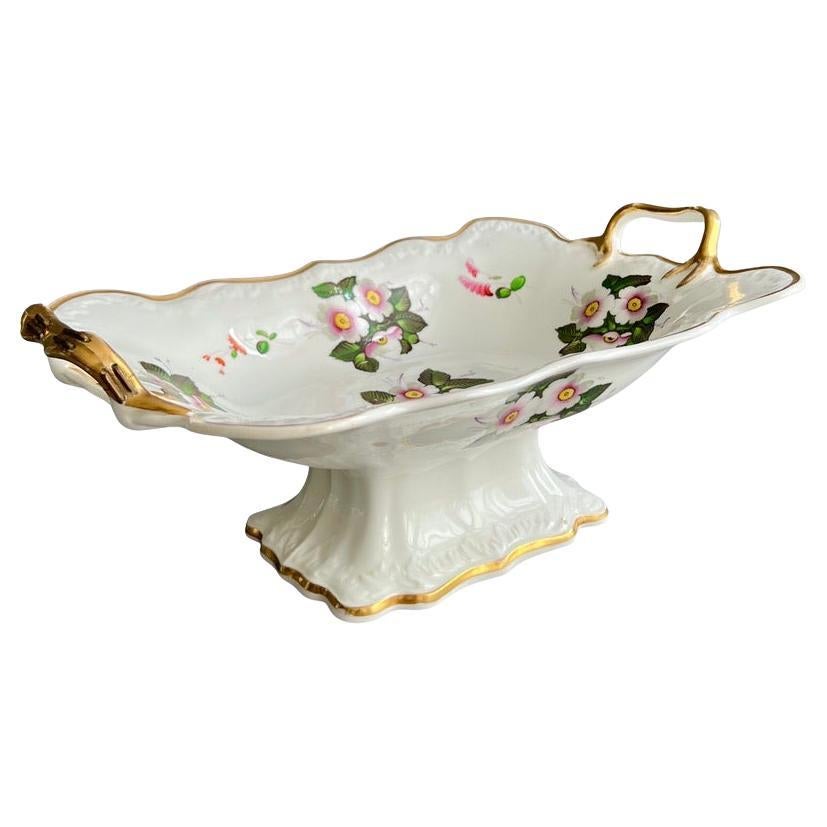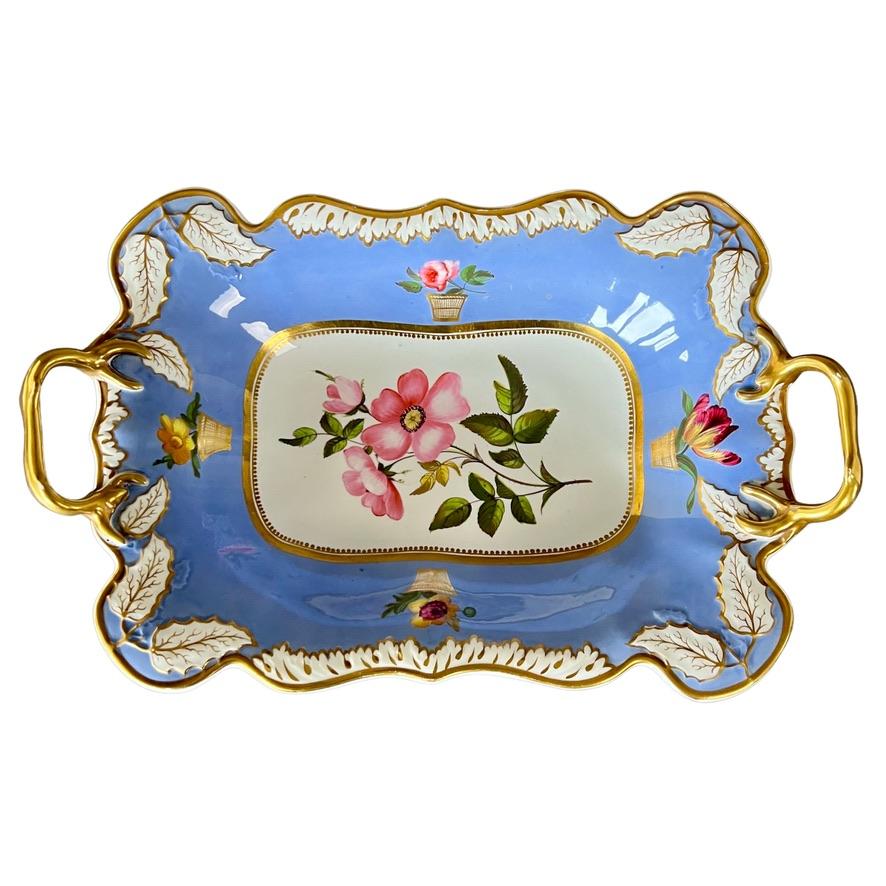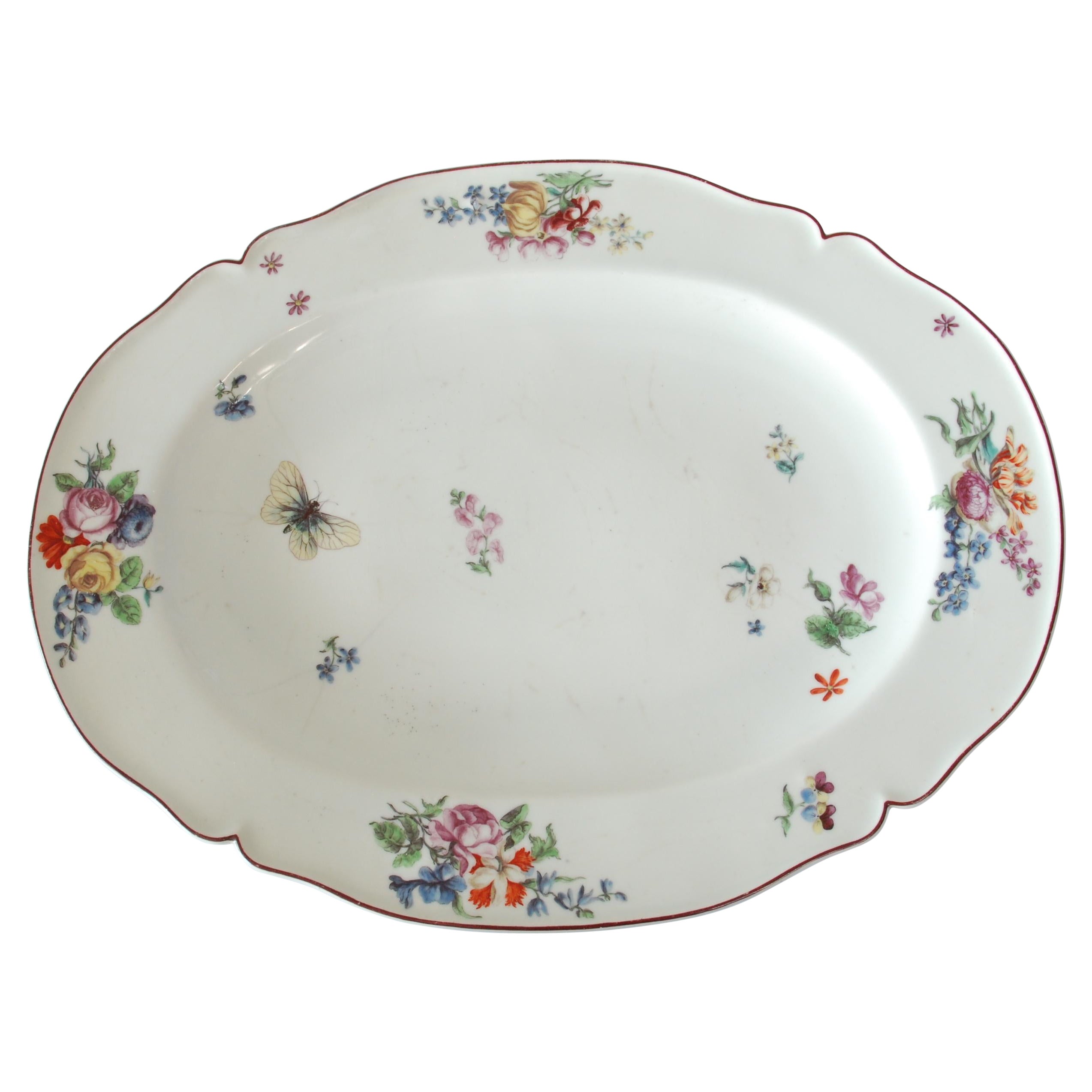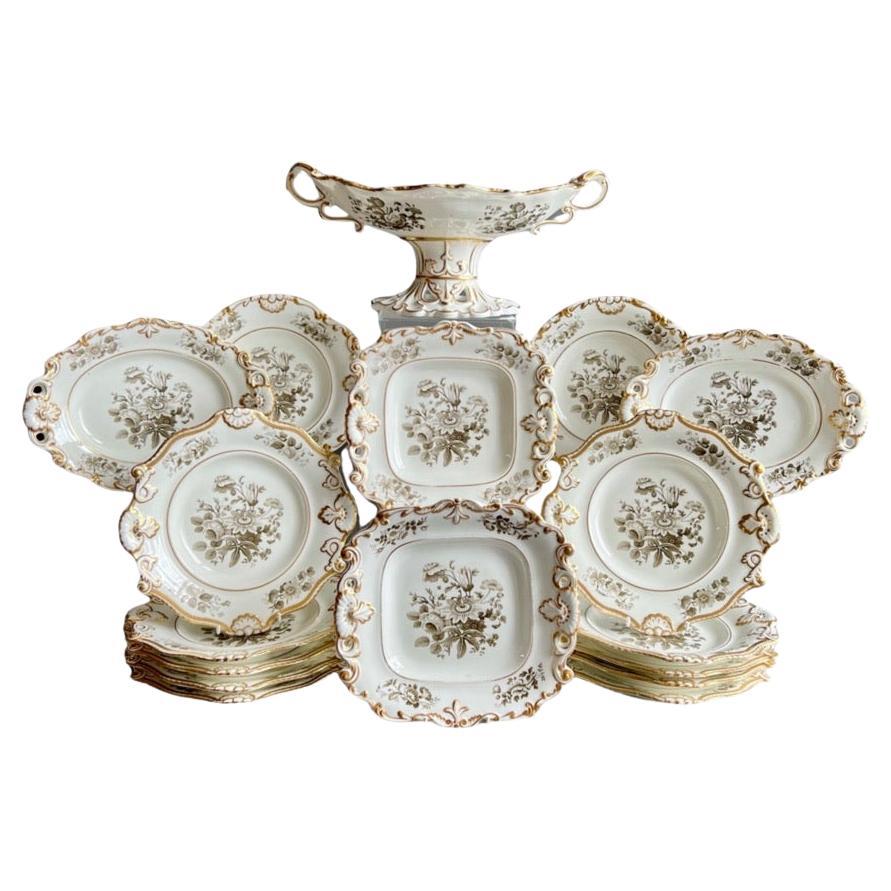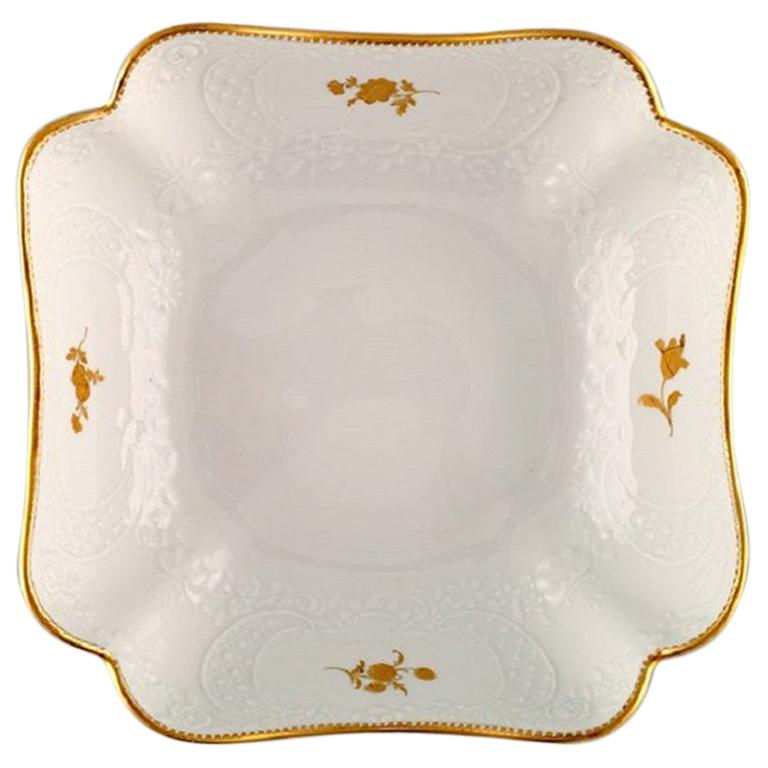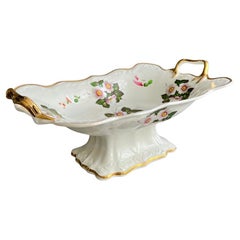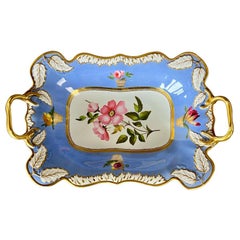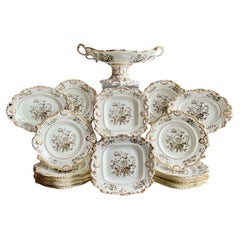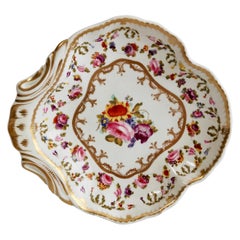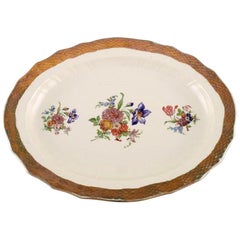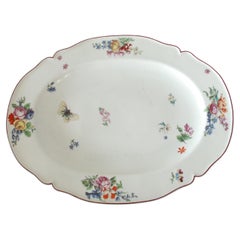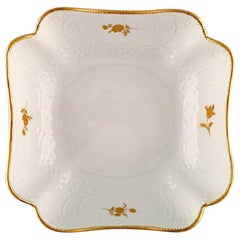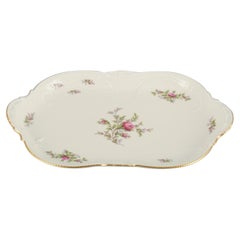Items Similar to Samuel Alcock Footed Comport, Embossed, White with Passion Flower, ca 1824
Want more images or videos?
Request additional images or videos from the seller
1 of 14
Samuel Alcock Footed Comport, Embossed, White with Passion Flower, ca 1824
$950
£721.68
€831.26
CA$1,359.07
A$1,490.54
CHF 768.73
MX$17,805.76
NOK 9,749.88
SEK 9,146.50
DKK 6,210.13
About the Item
A footed rectangular central comport or centre piece, embossed shape with rope handles; white with scattered white passion flowers and gilt handles.
Pattern 1061
Year: ca 1824
Size: 34cm X 23cm (13.5” X 9”)
Condition: a complex crack in the foot but still good for use.
The Samuel Alcock factory was operative in Staffordshire between 1822 and 1856, after which it was bought by Sir James Duke and Nephews. The factory started as a partnership between the young Samuel Alcock and the older Ralph Stevenson, who provided the factory and capital. Alcock quickly took the factory to great heights, building one of the biggest factories of its time. Alcock jumped on the new Rococo Revival fashion and served a huge new middle class market. The reason we now don't hear much about Samuel Alcock porcelain is that much of it has been mis-identified over the years and attributed to Coalport, Ridgway, Rockingham or others; Alcock did not mark any of his porcelain save a few rare pieces, and the numbering system is difficult to understand. However, the wares are still wide spread and many are of great quality.
This item forms part of the Murray Pollinger Collection of Samuel Alcock Porcelain. Most of the collection is not publicly available yet, but if you would like to get access to the first 100 lots, please sign up for our mailing list at the bottom of this page, and we will send you the full catalogue with more information, from which you can purchase more items.
Murray Pollinger was a passionate collector of Samuel Alcock porcelain. He was known as a true gentleman, impeccably dressed, always kind and modest - even some of his porcelain collecting friends had no idea about the size and importance of his collection. From the mid 1980s until shortly before his death in 2022 he collected many thousands of pieces and painstakingly catalogued them. He also went on trips to Staffordshire to discover the history of Samuel Alcock from whatever little documentation has been preserved. Through his painstaking work, Pollinger was able to make sense of the pattern numbering system that was used, and this was a huge step forward in identifying and understanding the porcelain. A website with the results of his research will be made available over the course of 2023. While he sold off about half of his collection in 2016, the remaining half is now made available to a new generation of collectors.
Antique British porcelain is never perfect. Kilns were fired on coal in the 1800s, and this meant that china from that period can have some firing specks from flying particles. British makers were also known for their experimentation, and sometimes this resulted in technically imperfect results. Due to the shrinkage in the kiln, items can have small firing lines or develop crazing over time, which should not be seen as damage but as an imperfection of the maker's recipes, probably unknown at the time of making. Items have often been used for many years and can have normal signs of wear, and gilt can have signs of slight disintegration even if never handled. I will reflect any damage, repairs, obvious stress marks, crazing or heavy wear in the item description but some minor scratches, nicks, stains and gilt disintegration can be normal for vintage items and need to be taken into account.
There is widespread confusion on the internet about the difference between chips and nicks, or hairlines and cracks. I will reflect any damage as truthfully as I can, i.e. a nick is a tiny bit of damage smaller than 1mm and a chip is something you can easily see with the eye; a glazing line is a break in the glazing only; hairline is extremely tight and/or superficial and not picked up by the finger; and a crack is obvious both to the eye and the finger. Etcetera - I try to be as accurate as I can and please feel free to ask questions or request more detailed pictures!
- Creator:Samuel Alcock & Co. (Maker)
- Dimensions:Height: 1 in (2.54 cm)Width: 1 in (2.54 cm)Depth: 1 in (2.54 cm)
- Style:Regency (Of the Period)
- Materials and Techniques:
- Place of Origin:
- Period:
- Date of Manufacture:circa 1824
- Condition:Wear consistent with age and use. a complex crack in the foot but still good for use.
- Seller Location:London, GB
- Reference Number:Seller: MP-ALC1621stDibs: LU4805146927822
About the Seller
5.0
Vetted Professional Seller
Every seller passes strict standards for authenticity and reliability
Established in 2016
1stDibs seller since 2019
227 sales on 1stDibs
Typical response time: 1 hour
- ShippingRetrieving quote...Shipping from: London, United Kingdom
- Return Policy
Authenticity Guarantee
In the unlikely event there’s an issue with an item’s authenticity, contact us within 1 year for a full refund. DetailsMoney-Back Guarantee
If your item is not as described, is damaged in transit, or does not arrive, contact us within 7 days for a full refund. Details24-Hour Cancellation
You have a 24-hour grace period in which to reconsider your purchase, with no questions asked.Vetted Professional Sellers
Our world-class sellers must adhere to strict standards for service and quality, maintaining the integrity of our listings.Price-Match Guarantee
If you find that a seller listed the same item for a lower price elsewhere, we’ll match it.Trusted Global Delivery
Our best-in-class carrier network provides specialized shipping options worldwide, including custom delivery.More From This Seller
View AllSamuel Alcock Footed Comport, Melted Snow, White with Dog Roses, ca 1823
By Samuel Alcock & Co.
Located in London, GB
A footed rectangular central comport or centre piece, melted snow borders and gilded twig handles, white with scattered pink dog roses (wild roses).
Pattern 847
Year: ca 1823
Size: ...
Category
Antique 1820s English Regency Serving Bowls
Materials
Porcelain
Samuel Alcock Footed Comport, Melted Snow, Periwinkle Lilac, Flowers, ca 1822
By Samuel Alcock & Co.
Located in London, GB
A footed rectangular central comport or centre piece, periwinkle / lilac ground with melted snow and holly leaf borders and flowers, a large pink wild rose painting...
Category
Antique 1820s English Regency Serving Bowls
Materials
Porcelain
Minton Dessert Service, Inverted Shell White with Monochrome Flowers, ca 1830
By Minton
Located in London, GB
This is a stunning dessert service made by Minton probably around the year 1830, in their "second period". The service consists of a high footed centre piece, two square dishes, two ...
Category
Antique 1830s English Rococo Revival Dinner Plates
Materials
Porcelain
$5,325 / set
Free Shipping
Bloor Derby Shell Dish, White, Floral Sprigs Moses Webster, Regency, 1820-1825
By Bloor Derby
Located in London, GB
This is a beautiful one-handled dessert serving dish or "shell" dish made by Derby between about 1820 and 1825 in the Regency era and decorated by Moses Webster. These dishes were to...
Category
Antique 1820s English Regency Serving Bowls
Materials
Porcelain
Chamberlains Worcester Dessert Service, White with Flowers, Regency, ca 1822
By Chamberlains Worcester
Located in London, GB
This is a spectacular and rare dessert service made by Chamberlains Worcester in about 1822. The service consists of a high comport, 2 square dishes, 1 kidney shaped dish, 3 shell di...
Category
Antique 1820s English Regency Dinner Plates
Materials
Porcelain
Samuel Alcock Plate, Grey and Beige Acanthus Border, Pink Flower, ca 1835
By Samuel Alcock & Co.
Located in London, GB
This is a beautiful plate with a warm grey and beige border of flowing acanthus leaves and pebble design with elaborate gilt, and a beautiful pink flower in the centre.
Pattern: 810...
Category
Antique 1830s English Rococo Revival Porcelain
Materials
Porcelain
You May Also Like
Royal Copenhagen Serving Dish in Porcelain with Floral Motifs and Gold Border
Located in København, Copenhagen
Royal Copenhagen serving dish in porcelain with floral motifs and gold border, mid-20th century.
Measures: 36 x 28 x 4 cm.
In good cond...
Category
Mid-20th Century Danish Porcelain
Materials
Porcelain
Large Dish or tureen stand, Chelsea, circa 1755
By Chelsea Porcelain
Located in Melbourne, Victoria
A fine tureen stand, typically painted with flowers and insects in the style of Meissen. A large and impressive piece.
Stilt marks and ground footrim.
Category
Antique Mid-18th Century English Neoclassical Porcelain
Materials
Porcelain
Meissen Porcelain Bowl with Flowers and Foliage in Relief
Located in København, Copenhagen
Meissen Porcelain bowl with flowers and foliage in relief and gold decoration, 20th century. Two pieces in stock.
Measures: 22.5 x 9.5 cm.
In very ...
Category
20th Century German Porcelain
Materials
Porcelain
Rosenthal, Germany, "Sanssouci", Cream-Coloured Serving Dish with Flowers
Located in København, Copenhagen
Rosenthal, Germany. "Sanssouci", a cream-coloured serving dish decorated with flowers and gold decoration.
Approx. 1930s.
In perfect condition.
First factory quality.
Marked.
Di...
Category
Vintage 1930s German Platters and Serveware
Materials
Porcelain
Antique Covered Serving Bowl or Tureen by Haviland Limoges
By Haviland & Co.
Located in Detroit, MI
This lovely vintage antique Haviland Limoges GDA France covered serving tureen or vegetable bowl is circa 1900-1941. It features a translucent white backgro...
Category
Early 20th Century French Country Serving Bowls
Materials
Porcelain
$206 Sale Price
25% Off
c. 1820 English Crown Derby Sweetmeat Dish
By Crown Derby
Located in Chapel Hill, NC
Circa 1820 Crown Derby sweetmeat dish, English. Heart lozenge form decorated with corn flowers with gilt highlights (some expected wear & minor rough area left edge).
10.5" x 8" x 1 ...
Category
Antique Early 19th Century English Victorian Serving Pieces
Materials
Porcelain
